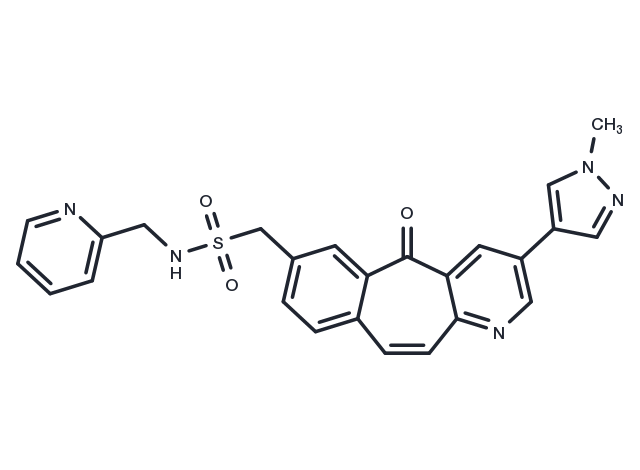Powder: -20°C for 3 years | In solvent: -80°C for 1 year


MK-8033 is a new and selective dual ATP competitive c-Met/Ron inhibitor (IC50: 1 nM Wt c-Met).

| Pack Size | Availability | Price/USD | Quantity |
|---|---|---|---|
| 1 mg | In stock | $ 98.00 | |
| 2 mg | In stock | $ 145.00 | |
| 5 mg | In stock | $ 247.00 | |
| 10 mg | In stock | $ 422.00 | |
| 25 mg | In stock | $ 689.00 | |
| 50 mg | In stock | $ 981.00 | |
| 1 mL * 10 mM (in DMSO) | In stock | $ 256.00 |

| Description | MK-8033 is a new and selective dual ATP competitive c-Met/Ron inhibitor (IC50: 1 nM Wt c-Met). |
| Targets&IC50 | c-Met (WT):1 nM (cell free), c-Met (N1100Y):1 nM (cell free) |
| In vitro | MK-8033 binds 3-fold more tightly to phosphorylated c-Met kinase domain (Kd: 3.2 nM) than to its unphosphorylated counterpart (Kd = 10.4 nM). Significantly, MK-8033 potently inhibits the kinase activity of three oncogenic c-Met activation loop mutants, Y1230C, Y1230H, and Y1235D (IC50s: 0.6~1 nM at 50 uM ATP) in addition to other c-Met activating mutants N1100Y and M1250T. MK-8033 potently inhibited GTL-16 proliferation (IC50: 582 nM). By contrast, the HCT116 cell line, which does not harbor basal c-Met activation, was not inhibited by MK-8033 (IC50 > 10000 nM) [1]. MK-8033 radiosensitizer the high-c-Met-expressing EBC-1 and H1993 cells but not the low-c-Met-expressing cell lines A549 and H460. However, irradiation of A549 and H460 cells increased the expression of c-Met protein at 30 minutes after the irradiation. Subsequent targeting of this up-regulated c-Met by using MK-8033 followed by a second radiation dose reduced the clonogenic survival of both A549 and H460 cells. MK-8033reduced the levels of radiation-induced phosphorylated (activated) c-Met in A549 cells [2]. |
| In vivo | MK-8033 was orally dosed in GTL-16 tumor xenograft bearing mice. Mice were euthanized 1 h after dosing and tested for p-Met (Y1349) in tumors and MK-8033 concentrations in plasma. At 100 mg/kg, essentially complete inhibition of p-Met (Y1349) was achieved. An in vivo IC50 of 1.3 uM was deduced from the relationship between plasma MK-8033 level and Met pY1349. Dosing at 3, 10, 30, and 100 mg/kg resulted in 22, 18, 57, and 86% tumor growth inhibition, respectively, relative to the tumor from vehicle-treated mice [1]. |
| Molecular Weight | 471.53 |
| Formula | C25H21N5O3S |
| CAS No. | 1001917-37-8 |
Powder: -20°C for 3 years | In solvent: -80°C for 1 year
DMSO: 45 mg/mL (97.83 mM)
You can also refer to dose conversion for different animals. More
bottom
Please see Inhibitor Handling Instructions for more frequently ask questions. Topics include: how to prepare stock solutions, how to store products, and cautions on cell-based assays & animal experiments, etc.
MK-8033 1001917-37-8 Tyrosine Kinase/Adaptors c-Met/HGFR bladder cancer breast cancer EBC-1 H1993 MK 8033 anti-tumor Inhibitor GTL-16 radiosensitivity Anti-ancer MK8033 NSCLCs inhibit inhibitor
